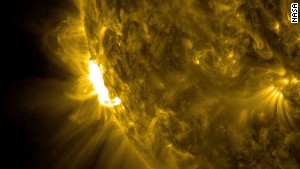NASA's deep-space craft readying for launch
|
|

Orion, the agency's
newest manned spaceship, is being prepared for its first mission in
December. In future missions, it will journey into deep space -- to Mars
and beyond -- farther than humans have ever gone before.
Orion comes loaded with superlatives.
It boasts the largest heat shield ever built and a computer 400 times
faster than the ones on the space shuttles. It will be launched into
space on the most powerful rocket NASA has ever made.
No astronauts will be aboard the December flight, which will test the spacecraft's systems for future manned missions.

NASA video captures huge solar flares

Watch astronauts play football in space
Final work on the
spacecraft is under way at the Kennedy Space Center in Florida. Orion
came one step closer to completion this month with the stacking of the
crew module atop the service module.
"Now that we're getting so close to launch, the spacecraft completion work is visible every day," Orion Program Manager Mark Geyer said in a statement.
A 3,600-mile journey
When complete, the Orion
capsule will resemble a fencing foil, with a tall spire shooting up from
a rounded base. At the top will sit a launch abort system, with
downward-facing thrusters that would save the crew from a jarring crash
in the event of a rocket malfunction.
The bottom portion, the
service module, will perform various functions such as in-space
propulsion and cargo storage. Nestled between the two will be the crew
module, capable of supporting human life from launch until recovery.
Attached to the service
module will be a United Launch Alliance Delta IV Heavy rocket. For the
first time since the space shuttle's debut launch in 1981, the crew
compartment will ride on the tip of the rocket rather than hanging onto
its side, evoking the configuration of the famous Apollo or Gemini
missions.
Come December, Orion
will be wheeled onto the Cape Canaveral launch pad and the countdown
will begin. If all goes as planned, the engines will rumble and its
rocket will thunder in an explosion of liquid oxygen, thrusting it
toward the stars.
The rocket will carry
the modules 3,600 miles above Earth, or about 16 times higher than the
average altitude of the International Space Station. Orion "is built to
take humans farther than they've ever gone before," NASA says.
Orion will orbit our
planet twice on its own during a 4½-hour journey before screaming back
into the Earth's atmosphere at nearly 20,000 miles per hour and
splashing down in the Pacific Ocean.
Future missions
Orion astronauts will enjoy access to unprecedented space travel technology.
NASA says the
spacecraft's onboard computer system can process 480 million
instructions per second, which is 400 times faster than the systems on
the space shuttle and 4,000 times faster than those on the Apollo
flights of the 1960s and early 1970s.
Orion also boasts the
largest heat shield ever built, designed to withstand temperatures that
would cause a nuclear reactor to melt down.
"Orion's flight test
will provide us with important data that will help us test out systems
and further refine the design so we can safely send humans far into the
solar system to uncover new scientific discoveries on future missions,"
Geyer said.
After Orion splashes down, NASA will begin preparing the spacecraft for the future manned missions for which it was designed.
"In the future, Orion
will launch on NASA's new heavy-lift rocket, the Space Launch System,"
the agency said. "More powerful than any rocket ever built, SLS will be
capable of sending humans to deep space destinations such as an asteroid
and eventually Mars."
The first astronauts
will travel into space aboard Orion in 2017. NASA hopes its Exploration
Mission-1, a 25-day flight around the moon's dark side, will demonstrate
Orion's reliability for deep space missions.
Exploration Mission-1
will send four astronauts farther than any human has been since the last
Apollo moon mission in 1972, laying the groundwork for future
endeavors.
NASA hopes Orion will
ring in a new era for crewed American space exploration, and American
flags may someday fly on more space outposts than just the moon.

No comments:
Post a Comment